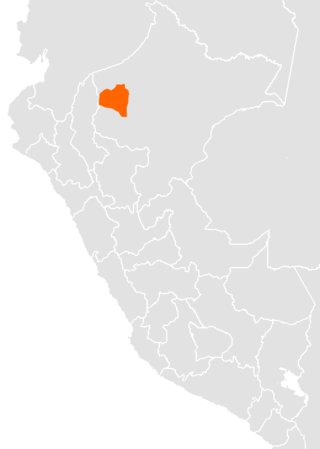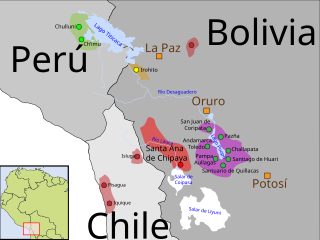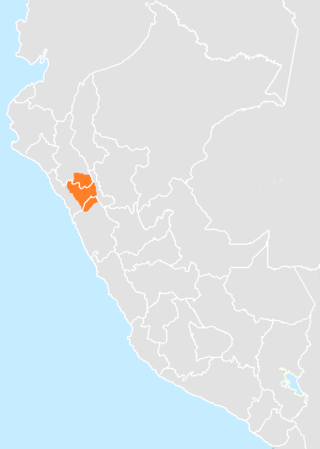
Quechua, also called Runasimi in Southern Quechua, is an indigenous language family that originated in central Peru and thereafter spread to other countries of the Andes. Derived from a common ancestral "Proto-Quechua" language, it is today the most widely spoken pre-Columbian language family of the Americas, with the number of speakers estimated at 8–10 million speakers in 2004, and just under 7 million from the most recent census data available up to 2011. Approximately 13.9% of Peruvians speak a Quechua language.

Tzotzil is a Maya language spoken by the Indigenous Tzotzil Maya people in the Mexican state of Chiapas. Most speakers are bilingual in Spanish as a second language. In Central Chiapas, some primary schools and a secondary school are taught in Tzotzil. Tzeltal is the most closely related language to Tzotzil and together they form a Tzeltalan sub-branch of the Mayan language family. Tzeltal, Tzotzil and Chʼol are the most widely spoken languages in Chiapas besides Spanish.

Chan Chan, sometimes itself called Chimor, was the capital city of the Chimor kingdom. It was largest city of the pre-Columbian era in South America. It is now an archeological site in the department of La Libertad five kilometers (3.1 mi) west of Trujillo, Peru.
Paezan may be any of several hypothetical or obsolete language-family proposals of Colombia and Ecuador named after the Paez language.

Puquina is a small, putative language family, often portrayed as a language isolate, which consists of the extinct Puquina language and Kallawaya, although it is assumed that the latter is just a remnant of the former mixed with Quechuan. Puquina speakers are last mentioned in the early nineteenth century.

Rodolfo Cerrón Palomino is a Peruvian linguist who has crucially contributed to the investigation and development of the Quechuan languages. He has also made outstanding contributions to the study of the Aymara, Mochica and Chipaya languages.
Chimuan or Yuncan is a hypothetical small extinct language family of northern Peru and Ecuador.

Located in the Chicama Valley, the El Brujo Archaeological Complex, just north of Trujillo, La Libertad Province, Peru, is an ancient archaeological site that was occupied from preceramic times. Considering the broad cultural sequencing, the Chicama Valley can be considered as an archaeological microcosm. Research at the site benefits from the favourable environmental and topological conditions for material conservation.
Huambisa, Huambiza, Wambiza, Jíbaro, Xívaro, Wampis, Maina, or Shuar-Huampis is an indigenous language of the Huambisa people of Peru. Spanish colonizers first generated the name Xívaro in the late 16th century as a way of overgeneralizing several ethnicities of similar sociopolitical statuses within the region and referring to them as savages. It is an established language spoken in the extreme north of Peru. It is closely related to the Achuar-Shiwiar, Shuar, and Aguaruna languages, all of which belong to the Jivaroan language family. It has official standing in the area it is spoken.

Candoshi-Shapra is an indigenous American language isolate, spoken by several thousand people in western South America along the Chapuli, Huitoyacu, Pastaza, and Morona river valleys. There are two dialects, Chapara and Kandoashi (Kandozi). It is an official language of Peru, like other native languages in the areas in which they are spoken and are the predominant language in use. Around 88.5 percent of the speakers are bilingual with Spanish. The literacy rate in Candoshi-Shapra is 10 to 30 percent and 15 to 25 percent in the second language Spanish. There is a Candoshi-Shapra dictionary, and grammar rules have been codified.

The Uru–Chipaya family is an indigenous language family of Bolivia.

Culle, also spelled Culli, Cullí, or Kulyi, is a poorly attested extinct language of the Andean highlands of northern Peru. It is the original language of the highlands of La Libertad Region, the south of the Cajamarca Region (Cajabamba), and the north of the Ancash region. It is known through various word lists collected while the language was still spoken and through vocabulary loaned into the Spanish spoken in the region.

Harakmbut or Harakmbet is the native language of the Harakmbut people of Peru. It is spoken along the Madre de Dios and Colorado Rivers, in the pre-contact country of the people. There are two dialects that remain vital: Amarakaeri (Arakmbut) and Watipaeri (Huachipaeri), which are reported to be mutually intelligible. The relationship between speakers of the two dialects is hostile.

Sechura–Catacao is a proposed connection between the small Catacaoan language family of Peru and the language isolate Sechura (Sek). The languages are extremely poorly known, but Kaufman (1990) finds the connection convincing, Campbell (2012) persuasive.
Moxo is any of the Arawakan languages spoken by the Moxo people of the Llanos de Moxos in northeastern Bolivia. The two extant languages of the Moxo people, Trinitario and Ignaciano, are as distinct from one another as they are from neighboring Arawakan languages. The extinct Magiana was also distinct.

Andean Spanish is a dialect of Spanish spoken in the central Andes, from southern Colombia, with influence as far south as northern Chile and Northwestern Argentina, passing through Ecuador, Peru, and Bolivia. While similar to other Spanish dialects, Andean Spanish shows influence from Quechua, Aymara, and other indigenous languages, due to prolonged and intense language contact. This influence is especially strong in rural areas.
Cajamarca Quechua is a variety of Quechua spoken in the districts of Chetilla, Baños del Inca and Cajamarca (Porcón) in the Peruvian province of Cajamarca, along the northwest coast of Peru.

The Codex Martínez Compañón (c.1782–1785), is a manuscript edited in nine volumes by the bishop of Trujillo, Peru, made by Baltasar Jaime Martínez Compañón, containing 1,411 watercolours and 20 musical scores documenting life in his diocese. This work was sent to Charles IV of Spain, who included it in the Royal Library in 1803. The musical examples in the bishop's text were probably written out by Pedro José Solis, maestro de capilla of Trujillo Cathedral from 1781 to 1823.
The tonada is a folk music style of Spain and some countries of Hispanic America. In modern-day Spain, the traditional sung piece known as tonada is considered as having been originated in Asturias and Cantabria, although tonada is a Spanish word which can mean anything sung, played or danced, musicological usage in Spanish and English is more specific.

The Quingnam language was a pre-Columbian language that was spoken by the Chimú people, who lived in the former territories of the Mochicas: an area north of the Chicama Chao River Valley. At the height of Chimú conquests, the language was spoken extensively from the Jequetepeque River in the north, to the Carabayllo in the south.

















